8+ Sample Work From Home Proposal
-
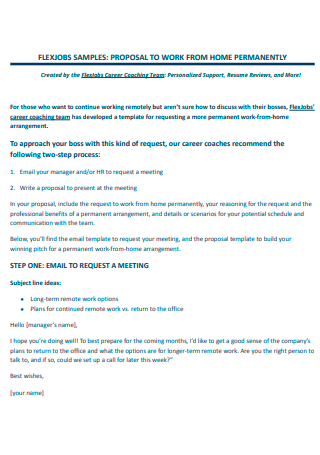
Work From Home Permanently Proposal
download now -
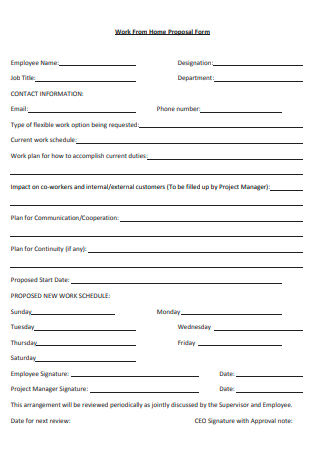
Work From Home Proposal Form
download now -
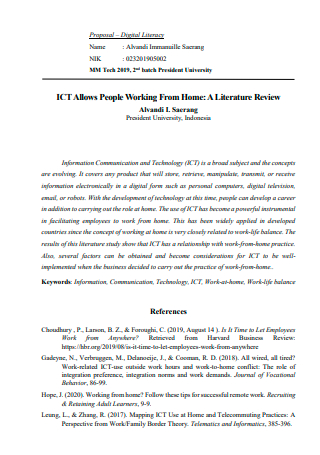
Basic Working From Home Proposal
download now -

Work From Home Telework Proposal
download now -
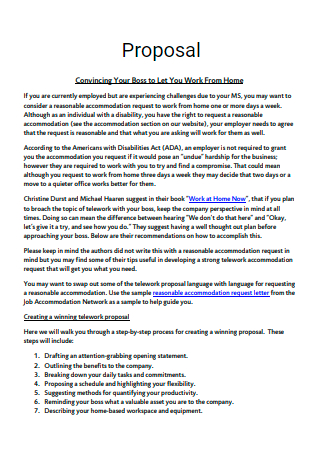
Work From Home Proposal Example
download now -
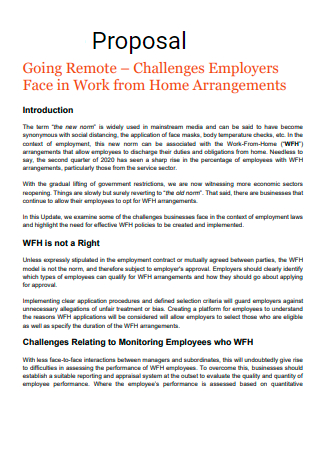
Work From Home Arrangements Proposal
download now -

Work From Home Request Proposal
download now -
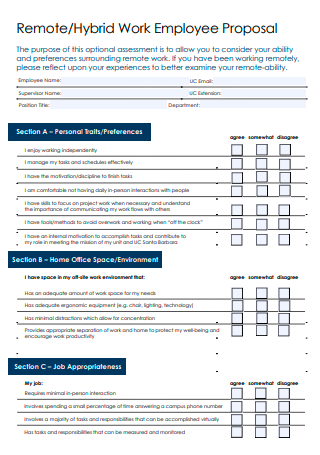
Employee Work From Home Proposal
download now -
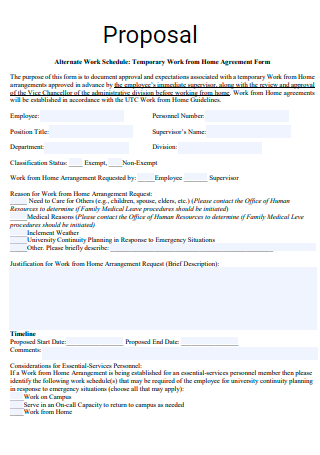
Work From Home Agreement Form Proposal
download now
FREE Work From Home Proposal s to Download
8+ Sample Work From Home Proposal
What Is a Work From Home Proposal?
Working from Home and its Benefits
5 Steps on How to Create a Rockstar Work from Home Proposal
FAQs
What are the usual objections coming from the employer when it comes to work from home setup?
What are the usual resources needed for a work from home setup?
What are some of the challenges in a work from home setup?
What Is a Work From Home Proposal?
A work from home proposal is a written request document that seeks permission to be allowed to work from home, or any other virtual office space other than the actual corporate office location. The main intent of the proposal is to persuade the recipient of the document that what you have presented is a sensible, logical idea that would greatly benefit all parties involved. It contains details of work plans on how to carry out the remote work setup, schedules, communication process, and even contingency plans in case the work is interrupted by unforeseen circumstances.
Work from home arrangement doesn’t only mean company employees being set up to work remotely. This would also extend to the current trend of online home-based work employment. The boom of the internet and social media saw the increase of online remote work through the form of outsourcing coming from companies in different countries. Outsourcing saves business owners time and money, especially when it comes to doing administrative tasks, marketing, and even doing sales campaign to promote their business. In fact, the whole business could be done 95% remotely! There is a massive demand for online freelancers, as this was further increased by businesses utilizing the internet as a marketing plan, or as a form of a marketing strategy to promote their products and services. So, whether you are a single parent, an online business entrepreneur, or a freelancer, having a work from home set up is the best kind of working arrangement that you could have in your situation.
Working from Home and its Benefits
Now, the only way to get your boss to approve your work from home proposal request is to show that it’s a win-win situation for the both of you. That you’re not just mooching off the company’s benefits and generosity. That you’re sincere in providing the company the services and skills that they required from you. That’s you’re still aligned with the overall company’s mission and vision goals. It’s not going to be easy getting your boss to sign off on your request and getting him or her to think from your point of view. Nevertheless, give it a go, and list down the benefits both of you could reap from you doing remote working.
5 Steps on How to Create a Rockstar Work from Home Proposal
Being aware of what the benefits of working from home are is one step. The next is writing them down and presenting them in a way that gets that big yes from your employer. Writing a work from home proposal can be a bit challenging, but once you get the gist and the elements of creating one, everything will just flow smoothly. Of course, it all revolves around the idea of what you and your employer can get from having a work from home setup. There is no hard and fast rule format for creating a proposal. All you need to do is just to have the essential elements in the right place. Here are some of the steps in writing that rockstar proposal that will give you a resounding yes from your boss.
Step 1: Write Your Introduction
The goal of the introduction is to get your employer’s interest to read your proposal. It should be brief and concise. A typical introduction would include your basic background information, your employment details such as your name and contact information, your title or position or the department you belong to, how long you have been working for the company, what qualifications and skills you have, et cetera.
Step 2: State your Proposal and the Purpose
Next, state the intent of your letter, which is what you are proposing and what is the reason behind your proposal. In this case, you propose that you are requesting from your employer that you would be allowed to work from home and that these would be the benefits it presents. Explain the driving reason that made you request that kind of working arrangement. Highlight your skills, qualifications, and even recognitions that you have that will make you worth it for the remote work setup. Be honest, sincere, direct to the point, but also be sure to keep your sentences short and simple.
Step 3: Lay Out your Work Plan
Present to your employer your suggested work plan for a remote work setting. Be sure that you covered all the areas when it comes to working, including your home office setup, your current network connectivity or internet connection, how you’ll be communicating with the company and vice versa, and what is the current home condition that you are in. A work plan, as an example, could include a trial period wherein you report for work directly at the office three times a week, and the rest of the days will be spent working at home, as a part of a transition period. If you’re in a supervisory position, and you need to have constant meetings with your subordinates, a work plan could be set up for regularly scheduled meetings through online meeting platforms such as Zoom, GoToMeeting, Google Workspace, et cetera. Make sure that your work plans have the core values of a SMART goal, meaning plans that are Specific, Measurable, Achievable, Relevant, and Time-bound. Assure your boss that your work plans will in no way slow down the company’s operation and will harm the business.
Step 4: Identify the Resources
Be honest if you need support and resources from the company to help you implement the work from home setup. Resources could be in the form of new computer hardware, software programs, or even stronger internet connectivity. But also make sure that these requests are reasonable, and that these will support as well to increase your productivity and the quality of your work output.
Step 5: Closing the Letter
Finish your proposal by thanking the recipient of the letter and providing your contact details in case they need to ask you further questions. Having a call to action statement will provide a sense of urgency and further enhance the purpose of your proposal. Give assurances as best as you can, letting your employer feel that you will always put your best foot forward, and keep your communication lines always open.
FAQs
What are the usual objections coming from the employer when it comes to work from home setup?
It is better to anticipate the objections coming your way so that you’ll have the chance to prepare to come up with the answers to those objections. Some of the usual objections are: how will they know that you are indeed working; if they allow you to work from home, then they’d have to do the same for everyone else; how can you ensure that you’ll keep company confidential information safe; how will you guarantee that you’re always available whenever the company needs to contact you or needs you to do something urgent; and how will you assure the company that your home problems won’t be affecting your work.
What are the usual resources needed for a work from home setup?
Typical resources needed are an updated computer setup with the latest software specifications, high-speed broadband internet access; VPN access to remotely and securely connect and access the company’s data; office software programs; a work phone, and a webcam.
What are some of the challenges in a work from home setup?
The number one challenge, that is also prevalent in almost all remote work environments, is a household distraction. The household distraction could mostly be from family members, not unless you’re home alone or have a separate room office where you can lock yourself up. Another challenge is the lack of human face-to-face interaction. This usually takes place if you’re living solo, and the face-to-face interaction you get to enjoy is coming from work colleagues, or friends at work. Another challenge is the feeling of being burnt out. Oftentimes, that thin line between work life and personal life gets crossed and broken, and you’d find yourself working harder, having no more personal “me” time for yourself, that you’d end up feeling more stressed than when you were working at the office. And the solution, therefore, is seeking more personal space and alone time.
Work from home benefits both the employee and the employer. Especially for a single working parent, having a work from home arrangement is the best solution for balancing family life, while working to be able to pay the bills. Asking your employer is the challenge, however, when it comes to a request of working remotely. There are a lot of considerations to be made, as well as objections that need to be anticipated. But if you feel that it’s worth all of it, then you need to be armed with a good work from home proposal.
We have an available work from home proposal template that you can download at your convenience. It is an easy template to fill out and follow-through. It helps you highlight the intent and purpose of your proposal, and also helps you present the advantages of working from home to your employer. Download one now, and get your work from home proposal signed off by your boss, with a big, resounding yes!
